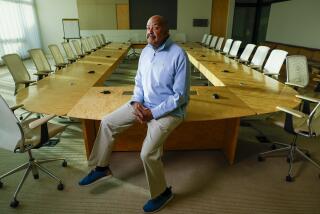Less Giving, More Work for O.C. Charities
- Share via
United Way of Orange County has extended its annual fund drive by one month this year.
The Salvation Army plans on decreasing the operation of its Santa Ana youth center by five hours each day.
And the Newport-Costa Mesa YMCA has found a way to save money by sharing facilities with a nearby boys and girls club.
“It’s the wave of the future,” said George Scobas, the YMCA’s executive director. “Nonprofits have to work together to make it through these hard times.”
Indeed, nonprofit agencies in Orange County are responding in a variety of ways to a holiday season that, in terms of charity giving, promises to be one of the leanest in memory.
Many agencies time their major fund-raising drives to coincide with the holiday season. Yet in interview after interview, agency administrators reported donations that are lagging behind last year’s by as much as 75%.
Their experiences are confirmed by the recently released 1992 Orange County Annual Survey indicating that the county’s median household income has declined from $49,000 to $45,000 and that charity giving has dipped to its lowest level in six years.
“It’s enough to make me just a little bit nervous,” said Lt. Lee Lescano, county coordinator for the Salvation Army, where the annual Christmas appeal is bringing in about 30% less money than in 1991.
Most of the administrators blamed their situations on the economy.
“It’s not that people don’t want to be generous,” said Jean Wegener, director of administration for Serving People in Need, which helps homeless people. “It’s that they’re struggling to survive themselves, and those who aren’t struggling are holding on to what they have to prepare for the future.”
Her own agency--run on an annual budget of $358,000--expects to finish the year with 25% to 30% less in donations than it received last year.
“They might want to give,” Wegener said, “but they’re afraid to.”
Linda Fedrick, assistant to the executive director of the Irvine-based CSP (Community Service Programs) Inc., agrees.
“The economy is affecting all levels of society,” said Fedrick, whose agency acts as an umbrella organization for a number of youth-oriented programs throughout the county. Run on an annual budget of $4.5 million, CSP has experienced a 20% to 25% dip in donations this year.
Interestingly, the loss of cash donations in some cases is being accompanied by a corresponding increase in volunteerism and in-kind donations. Administrators at Child or Parental Emergency Services in Santa Ana say they expect to receive only about $1,000 in donations this holiday season contrasted with the usual $4,000. Yet the number of holiday gifts they have received for needy families has more than doubled.
And at the Orange Coast Interfaith Shelter in Costa Mesa, a 20% drop in cash donations has been accompanied by a 20% increase in donations of food, clothing and items of hygiene. “It balances out somewhat,” said executive director Sandee Gordon, but “food drives still won’t pay the electric bill.”
Even at the handful of agencies where donations have gone up, financial gains have been largely wiped out by increased demands for services.
The Food Distribution Center in Orange, which provides food for 240 private agencies countywide on an annual budget of about $1.2 million, just ended its fiscal year with a 46% increase in monetary donations--from $420,000 to $610,000--over the year before. Administrators attribute the increased income to more aggressive efforts on their part to solicit donors and to recent publicity given to the issue of hunger worldwide.
Yet during the same period, according to director Fred Pratt, requests for food have increased by 50% to 100%.
“There’s no question about it,” Pratt said, “there is simply not enough food in the county (to satisfy) all the requests we get from agencies.”
Nonprofit groups have adopted a number of strategies to cope with the new dearth of financial support.
United Way of Orange County, which supports about 1,100 agencies countywide on a $20.5-million budget that is likely to be 5% to 10% less this year, decided to extend its current fund-raising drive through the end of February. The drive usually concludes in January.
In addition, said communications director Jeff Rocke, the agency has contacted about 3,000 more potential donor-organizations than it did last year in an effort to broaden its base of support.
Beginning Jan. 1, the Salvation Army’s Santa Ana youth center will open at 1 p.m., instead of 8 a.m. as now is the case.
And the Newport-Costa Mesa Family YMCA has combined efforts with the Boys and Girls Club of the Harbor Area-Irvine Branch in an unusual way to broaden services and save money for each organization.
At the boys and girls club, workers hired by the YMCA are busy remodeling a 3,000-square-foot area that has been underused.
When the work is done, probably by mid-January, the YMCA plans on leasing the area from the boys and girls club for use as an office and recreational space. That way, the youth club derives much-needed income from an otherwise little-used space, and the YMCA gets to expand at a reasonable cost.
Administrators at each organization say the services offered at the facility will complement, rather than compete with, one another.
“We weren’t using the room,” said Dick Power, executive director of the boys and girls club which, among other things, is raising its fees to help defray a projected 2% drop in contributions. “They will have programs that are not in conflict with ours.”
Scobas, of the YMCA, says “they will help us and we will help them. By collaborating together, we can make both agencies stronger.”
At the heart of the crisis is genuine alarm. How can organizations already pared to the bone survive yet another paring? Some administrators wonder.
“We’ve reduced staff hours and downsized,” said Mary Douglas, executive director of the the Santa Ana YWCA, where contributions have fallen almost 50%. “We’re down to the bone marrow as far as staff is concerned.”
Yet, charity administrators remain optimistic.
“We hold out great hope that things can change,” Douglas said. “My belief is that things will have to get better; if they don’t it’s just too much to consider. I guess I’m hoping for a miracle.”
More to Read
Sign up for Essential California
The most important California stories and recommendations in your inbox every morning.
You may occasionally receive promotional content from the Los Angeles Times.













